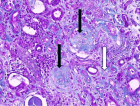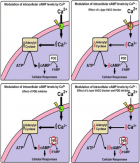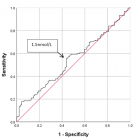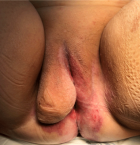Abstract
Review Article
Flow cytometry potential applications in characterizing solid tumors main phenotype, heterogeneity and circulating cells
Louis WAECKEL, Guorong LI, Anne-Emmanuelle BERGER and Claude LAMBERT*
Published: 24 August, 2021 | Volume 5 - Issue 1 | Pages: 010-015
Flow cytometry (FCM) is a unique technique that allows rapid quantitative measurement of multiple parameters on a large number of cells at the individual level. FCM is based on immunolabelling with fluorochrome-conjugated antibodies, leading to high sensitivity and precision while time effective sample preparation. FCM can be performed on tissue following enzymatic or mechanical dissociation. The expression of epithelial antigens and cytokeratin isoforms help in distinguishing tumor cells from adjacent epithelial cells and from tumor infiltrating leukocytes. Tumor phenotypes can be characterized on expression intensity, aberrancies and presence of tumor-associated antigens as well as their cell proliferation rate and eventual heteroploidy. FCM can measure quantitative expression of hormone or growth factor receptors, immunoregulatory proteins to guide adjuvant therapy. Expression of adhesion molecules tells on tumor’s capacity for tissue invasion and metastasis seeding. Tumor heterogeneity can be explored quantitatively and rare, potentially emerging, clones with poor prognosis can be detected. FCM is easily applicable on fine needle aspiration and in any tumor related biological fluids. FCM can also be used to detect circulating tumor cells (CTC) to assess metastatic potential at diagnosis or during treatment. Detecting CTC could allow early detection of tumors before they are clinically expressed although some difficulties still need to be solved. It thus appears that FCM should be in the pathologist tool box to improve cancer diagnosis, classification and prognosis evaluation as well as in orientating personalized adjuvant therapy and immunotherapy. More developments are still required to better known tumor phenotypes and their potential invasiveness
Read Full Article HTML DOI: 10.29328/journal.apcr.1001022 Cite this Article Read Full Article PDF
Keywords:
Flow cytometry; Solid tumor heterogeneity; Tumor cells; Tumor antigens; Liquid biopsy
References
- Lambert C, Preijers FWMB, Demirel GY, Sack U. Monocytes and macrophages in flow: an ESCCA initiative on advanced analyses of monocyte lineage using flow cytometry Cytometry B Clin Cytom. 2017; 92: 180-188. PubMed: https://pubmed.ncbi.nlm.nih.gov/26332381/
- Passebosc-Faure K, Li G, Lambert C, Cottier M, Gentil-Perret A, et al. Evaluation of a panel of molecular markers for the diagnosis of malignant serous effusions. Clin Cancer Res. 2005;11: 6862-6867. PubMed: https://pubmed.ncbi.nlm.nih.gov/16203775/
- Davidson B, Dong HP, Holth A, Berner A, Risberg B. Flow cytometric immunophenotyping of cancer cells in effusion specimens: diagnostic and research applications.Diagn Cytopathol. 2007; 35: 568-578. PubMed: https://pubmed.ncbi.nlm.nih.gov/17703449/
- Bongiovanni M, Triponez F, McKee TA, Kumar N, Matthes T, e al. Fine-needle aspiration of the diffuse sclerosing variant of papillary thyroid carcinoma masked by florid lymphocytic thyroiditis; A potential pitfall: A case report and review of the literature. Diagn Cytopathol. 2009;37: 671-675. PubMed: https://pubmed.ncbi.nlm.nih.gov/19373906/
- Kawashima A, Uemura M, Nonomura N. Importance of Multiparametric Evaluation of Immune-Related T-Cell Markers in Renal-Cell Carcinoma.Clin Genitourin Cancer. 2019;17: e1147-e1152. PubMed: https://pubmed.ncbi.nlm.nih.gov/31473121/
- Gires O, Pan M, Schinke H, Canis M, Baeuerle PA. Expression and function of epithelialcell adhesion molecule EpCAM: where are we after 40 years? Cancer Metastasis Rev. 2020;39: 969-987. PubMed: https://pubmed.ncbi.nlm.nih.gov/32507912/
- Chen W, Zhang Z, Zhang S, Zhu P, Ko JK, et al. MUC1: Structure, Function, and Clinic Application in Epithelial Cancers. Int J Mol Sci. 2021;22: PubMed: https://www.ncbi.nlm.nih.gov/pmc/articles/PMC8234110/
- Eslami SZ, Cortés-Hernández LE, Alix-Panabières C. EpithelialCell Adhesion Molecule: An Anchor to Isolate Clinically Relevant Circulating Tumor Cells. 2020;9: 1836. PubMed: https://pubmed.ncbi.nlm.nih.gov/32764280/
- Polari L, Alam CM, Nyström JH, Heikkilä T, Tayyab M, et al. Keratin intermediate filaments in the colon: guardians of epithelial Int J Biochem Cell Biol. 2020;129: 105878. PubMed: https://pubmed.ncbi.nlm.nih.gov/33152513/
- Werner S, Keller L, Pantel K. Epithelialkeratins: Biology and implications as diagnostic markers for liquid biopsies. Mol Aspects Med. 2020;72: PubMed: https://pubmed.ncbi.nlm.nih.gov/31563278/
- Bornes L, Belthier G, van Rheenen J. Epithelial-to-Mesenchymal Transition in the Light of Plasticity and Hybrid E/M States. J Clin Med. 2021; 10: PubMed: https://pubmed.ncbi.nlm.nih.gov/34072345/
- Dmello C, Srivastava SS, Tiwari R, Chaudhari PR, Sawant S, et al. Multifaceted role of keratinsin epithelial cell differentiation and transformation. J Biosci. 2019;44: PubMed: https://pubmed.ncbi.nlm.nih.gov/31180046/
- Fagotto F, Aslemarz A. EpCAM cellular functions in adhesionand migration, and potential impact on invasion: A critical review. Biochim Biophys Acta Rev Cancer. 2020;1874: PubMed: https://pubmed.ncbi.nlm.nih.gov/32976980/
- Zhao X, Pan X, Wang Y, Zhang Y. Targeting neoantigens for cancer immunotherapy. Biomark Res. 2021;9: PubMed: https://pubmed.ncbi.nlm.nih.gov/34321091/
- Groux-Degroote S, Delannoy P.Cancer-Associated Glycosphingolipids as TumorMarkers and Targets for Cancer Immunotherapy. Int J Mol Sci. 2021;22: PubMed: https://pubmed.ncbi.nlm.nih.gov/34200284/
- Goldberg J, Pastorello RG, Vallius T, Davis J, Cui YX, et al.The Immunology of Hormone Receptor Positive Breast Cancer. Front Immunol. 2021;12: PubMed: https://pubmed.ncbi.nlm.nih.gov/34135901/
- Dominiak A, Chełstowska B, Olejarz W, Nowicka G. Communication in the Cancer Microenvironment as a Target for Therapeutic Interventions. Cancers (Basel). 2020; 12: PubMed: https://pubmed.ncbi.nlm.nih.gov/32422889/
- Saraon P, Pathmanathan S, Snider J, Lyakisheva A, Wong V, et al. Receptor tyrosine kinases and cancer: oncogenic mechanisms and therapeutic approaches. 2021; 40: 4079-4093. PubMed: https://pubmed.ncbi.nlm.nih.gov/34079087/
- Yang HH, Liu JW, Lee JH, Harn HJ, Chiou TW. Pancreatic Adenocarcinoma Therapeutics Targeting RTK and TGF Beta Receptor. Int J Mol Sci. 2021; 22: PubMed: https://pubmed.ncbi.nlm.nih.gov/34360896/
- Lv Q, Zhang J, Yi Y, Huang Y, Wang Y, et al. Proliferating Cell Nuclear Antigen Has an Association with Prognosis and Risks Factors of Cancer Patients: a Systematic Review. Mol Neurobiol. 2016;53: 6209-6217. PubMed: https://pubmed.ncbi.nlm.nih.gov/26558632/
- Vijayakumar G, Sharma G, Narwal A, Kamboj M. Broder versus Bryne'shistologic grading parameters on incision biopsy specimens: A comparative study with P53 and KI67 J Oral Maxillofac Pathol. 2021;25: 55-60. PubMed: https://pubmed.ncbi.nlm.nih.gov/34349412/
- Wen KW, Rabinovitch PS, Wang D, Mattis AN, Ferrell LD, et al. Utility of DNAflow cytometry in distinguishing between malignant and benign intrahepatic biliary lesions. Virchows Arch. 2020;477: 527-534. PubMed: https://pubmed.ncbi.nlm.nih.gov/32296928/
- Lee H, Rabinovitch PS, Mattis AN, Kakar S, Choi WT. DNAflow cytometric analysis of paraffin-embedded tissue for the diagnosis of malignancy in bile duct biopsies. Hum Pathol. 2020;99: 80-87. PubMed: https://pubmed.ncbi.nlm.nih.gov/32272125/
- Diener MK, Fichtner-Feigl S. Biomarkers in colorectal liver metastases: Rising complexity and unknown clinical significance? Ann Gastroenterol Surg. 2021;5: 477-483. PubMed: https://pubmed.ncbi.nlm.nih.gov/34337296/
- Kern R, Panis C. CTLA-4 Expression and Its Clinical Significance in Breast Cancer. Arch Immunol Ther Exp (Warsz). 2021;69: PubMed: https://pubmed.ncbi.nlm.nih.gov/34148159/
- Munari E, Mariotti FR, Quatrini L, Bertoglio P, Tumino N et alPD-1/PD-L1 in Cancer: Pathophysiological, Diagnostic and Therapeutic Aspects. Int J Mol Sci. 2021;22: PubMed: https://pubmed.ncbi.nlm.nih.gov/34066087/
- Ding Z, He Y, Fu Y, Zhu N, Zhao M, et al. CD38 Multi-Functionality in Oral Squamous Cell Carcinoma: Prognostic Implications, Immune Balance, and Immune Checkpoint. Front Oncol. 2021;11: PubMed: https://pubmed.ncbi.nlm.nih.gov/34211854/
- Qin Y, Peng F, Ai L, Mu S, Li Y, et al. Tumor-infiltratingB cells as a favorable prognostic biomarker in breast cancer: a systematic review and meta-analysis. Cancer Cell Int. 2021;21:
- Wang S, Sun J, Chen K, Ma P, Lei Q, et al. Perspectives of tumor-infiltratinglymphocyte treatment in solid tumors. BMC Med. 2021; 19: PubMed: https://pubmed.ncbi.nlm.nih.gov/34112147/
- Fan P, Li X, Feng Y, Cai H, Dong D, et al PD-1 Expression Status on CD8+ TumourInfiltrating Lymphocytes Associates With Survival in Cervical Cancer. Front Oncol. 2021;11: PubMed: https://pubmed.ncbi.nlm.nih.gov/34150643/
- Shibru B, Fey K, Fricke S, Blaudszun AR, Fürst F, et al.Detection of Immune Checkpoint Receptors - A Current Challenge in Clinical FlowCytometry. Front Immunol. 2021;12: PubMed: https://pubmed.ncbi.nlm.nih.gov/34276685/
- Ostrand-Rosenberg S, Fenselau C. Myeloid-Derived Suppressor Cells: Immune-Suppressive Cells That Impair Antitumor Immunity and Are Sculpted by Their Environment. J Immunol. 2018; 200: 422-431. PubMed: https://pubmed.ncbi.nlm.nih.gov/29311384/
- Gu W, Talevich E, Hsu E, Qi Z, Urisman A, et al. Detection of cryptogenic malignancies from metagenomic whole genome sequencing of body fluids. Genome Med. 2021;13: PubMed: https://pubmed.ncbi.nlm.nih.gov/34074327/
- Mistry AM, Greenplate AR, Ihrie RA, Irish JM. Beyond the message: advantages of snapshot proteomics with single-cell mass cytometry in solid tumors. FEBS J. 2019; 286: 1523-1539. PubMed: https://pubmed.ncbi.nlm.nih.gov/30549207/
- Baraniskin A, Schroers R. Liquid Biopsy and Other Non-Invasive Diagnostic Measures in PCNSL. Cancers (Basel). 2021;13: PubMed: https://pubmed.ncbi.nlm.nih.gov/34071407/
- Wijewardene AA, Chehade M, Gild ML, Clifton-Bligh RJ, Bullock M. Translational Utility of Liquid Biopsies in Thyroid Cancer Management.Cancers (Basel). 2021;13: 3443. PubMed: https://pubmed.ncbi.nlm.nih.gov/34298656/
- Romano C, Martorana F, Pennisi MS, Stella S, Massimino M, et al. Opportunities and Challenges of Liquid Biopsy in Thyroid Cancer.Int J Mol Sci. 2021;22: 7707.
- Yang C, Chen F, Wang S, Xiong B. Circulating Tumor Cells in Gastrointestinal Cancers: Current Status and Future Perspectives.Front Oncol. 2019;9: 1427. PubMed: https://pubmed.ncbi.nlm.nih.gov/31921680/
- Lei MML, Lee TKW. Cancer Stem Cells: Emerging Key Players in Immune Evasion of Cancers. Front Cell Dev Biol. 2021;9: 692940.PubMed: https://pubmed.ncbi.nlm.nih.gov/34235155/
- Rushton AJ, Nteliopoulos G, Shaw JA, Coombes RC.A Review of Circulating Tumour CellEnrichment Technologies. Cancers (Basel). 2021;13: PubMed: https://pubmed.ncbi.nlm.nih.gov/33652649/
- Shukla S, Gupta A, Awasthi NP, Chandra S, Singh P et al. The Utility of Ancillary Techniques in the Cyto-Diagnosisof Malignant Scalp Lesions. J Cytol. 2021;38: 74-81. PubMed: https://pubmed.ncbi.nlm.nih.gov/34321773/
- Li G, Mallouk N, Flandrin P, Garcin A, Lambert C, et al. Presence of Urinary Exosomes for Liquid Biopsy of Clear Cell Renal Cell Carcinoma: Protocol for a Pilot Feasibility Study. JMIR Res Protoc. 2021;10:PubMed: https://pubmed.ncbi.nlm.nih.gov/34283029/
- Li Q, Cai S, Li M, Salma KI, Zhou X, Han F, Chen J, Huyan T. Tumor-Derived Extracellular Vesicles: Their Role in Immune Cells and Immunotherapy. Int J Nanomedicine. 2021; 16:5395-5409. PubMed: https://pubmed.ncbi.nlm.nih.gov/34408415/
Similar Articles
-
Detection of IDH mutations in cerebrospinal fluid: A discussion of liquid biopsy in neuropathologyMing Lee*,Gek San Tan,Chee Kian Tham,Kiat-Hon Tony Lim. Detection of IDH mutations in cerebrospinal fluid: A discussion of liquid biopsy in neuropathology. . 2020 doi: 10.29328/journal.apcr.1001018; 4: 011-023
-
Flow cytometry potential applications in characterizing solid tumors main phenotype, heterogeneity and circulating cellsLouis WAECKEL,Guorong LI,Anne-Emmanuelle BERGER,Claude LAMBERT*. Flow cytometry potential applications in characterizing solid tumors main phenotype, heterogeneity and circulating cells. . 2021 doi: 10.29328/journal.apcr.1001022; 5: 010-015
Recently Viewed
-
Obesity in Patients with Chronic Obstructive Pulmonary Disease as a Separate Clinical PhenotypeDaria A Prokonich*, Tatiana V Saprina, Ekaterina B Bukreeva. Obesity in Patients with Chronic Obstructive Pulmonary Disease as a Separate Clinical Phenotype. J Pulmonol Respir Res. 2024: doi: 10.29328/journal.jprr.1001060; 8: 053-055
-
Current Practices for Severe Alpha-1 Antitrypsin Deficiency Associated COPD and EmphysemaMJ Nicholson*, M Seigo. Current Practices for Severe Alpha-1 Antitrypsin Deficiency Associated COPD and Emphysema. J Pulmonol Respir Res. 2024: doi: 10.29328/journal.jprr.1001058; 8: 044-047
-
Navigating Neurodegenerative Disorders: A Comprehensive Review of Current and Emerging Therapies for Neurodegenerative DisordersShashikant Kharat*, Sanjana Mali*, Gayatri Korade, Rakhi Gaykar. Navigating Neurodegenerative Disorders: A Comprehensive Review of Current and Emerging Therapies for Neurodegenerative Disorders. J Neurosci Neurol Disord. 2024: doi: 10.29328/journal.jnnd.1001095; 8: 033-046
-
Metastatic Brain Melanoma: A Rare Case with Review of LiteratureNeha Singh,Gaurav Raj,Akshay Kumar,Deepak Kumar Singh,Shivansh Dixit,Kaustubh Gupta*. Metastatic Brain Melanoma: A Rare Case with Review of Literature. J Radiol Oncol. 2025: doi: 10.29328/journal.jro.1001080; 9: 050-053
-
Validation of Prognostic Scores for Attempted Vaginal Delivery in Scar UterusMouiman Soukaina*,Mourran Oumaima,Etber Amina,Zeraidi Najia,Slaoui Aziz,Baydada Aziz. Validation of Prognostic Scores for Attempted Vaginal Delivery in Scar Uterus. Clin J Obstet Gynecol. 2025: doi: 10.29328/journal.cjog.1001185; 8: 023-029
Most Viewed
-
Evaluation of Biostimulants Based on Recovered Protein Hydrolysates from Animal By-products as Plant Growth EnhancersH Pérez-Aguilar*, M Lacruz-Asaro, F Arán-Ais. Evaluation of Biostimulants Based on Recovered Protein Hydrolysates from Animal By-products as Plant Growth Enhancers. J Plant Sci Phytopathol. 2023 doi: 10.29328/journal.jpsp.1001104; 7: 042-047
-
Sinonasal Myxoma Extending into the Orbit in a 4-Year Old: A Case PresentationJulian A Purrinos*, Ramzi Younis. Sinonasal Myxoma Extending into the Orbit in a 4-Year Old: A Case Presentation. Arch Case Rep. 2024 doi: 10.29328/journal.acr.1001099; 8: 075-077
-
Feasibility study of magnetic sensing for detecting single-neuron action potentialsDenis Tonini,Kai Wu,Renata Saha,Jian-Ping Wang*. Feasibility study of magnetic sensing for detecting single-neuron action potentials. Ann Biomed Sci Eng. 2022 doi: 10.29328/journal.abse.1001018; 6: 019-029
-
Pediatric Dysgerminoma: Unveiling a Rare Ovarian TumorFaten Limaiem*, Khalil Saffar, Ahmed Halouani. Pediatric Dysgerminoma: Unveiling a Rare Ovarian Tumor. Arch Case Rep. 2024 doi: 10.29328/journal.acr.1001087; 8: 010-013
-
Physical activity can change the physiological and psychological circumstances during COVID-19 pandemic: A narrative reviewKhashayar Maroufi*. Physical activity can change the physiological and psychological circumstances during COVID-19 pandemic: A narrative review. J Sports Med Ther. 2021 doi: 10.29328/journal.jsmt.1001051; 6: 001-007

HSPI: We're glad you're here. Please click "create a new Query" if you are a new visitor to our website and need further information from us.
If you are already a member of our network and need to keep track of any developments regarding a question you have already submitted, click "take me to my Query."



















































































































































